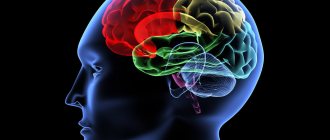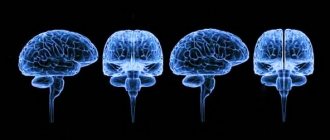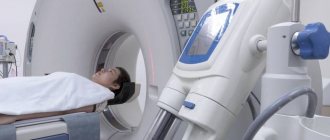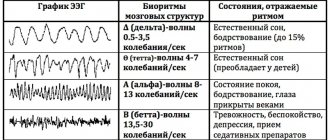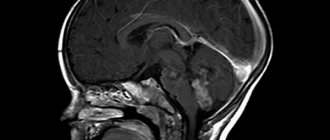Irritation of the cortex covering the deep structures of the brain is a natural process that normally occurs as a result of exposure to external factors, which forces the central nervous system to react and form a physiological response. Pathologies of nervous structures provoke disturbances in the functioning of the brain, which is reflected in irritation (irritation) of its parts without the influence of external stimuli. This condition leads to malfunctions in all body systems. Diagnosed at any age, regardless of the person’s gender.
Definition of pathology
Irritative disorders arise due to disruption of the transmission of nerve impulses, which provokes a deterioration in brain activity. Irritation of the cortex covering the brain is a pathological condition that is manifested by the spontaneous appearance of a focus of irritation in a certain area, which leads to the appearance of characteristic symptoms. An example of a normal reaction of the nervous system to an external irritant is a decrease in pupil diameter in response to bright light, which occurs as a result of irritation of the optic nerve.
Spontaneous irritation without obvious reasons is a pathology that significantly complicates a person’s life. Irritation of areas of the brain is not included in the international list of diseases ICD-10, because more often irritation of the cortical, median (deep), diencephalic structures is a symptom of the primary disease. Among the pathologies manifested by similar symptoms, it is worth noting a tumor localized in the brain tissue, organic damage to the nervous tissue of various etiologies.
There are focal (irritation of a local area of the cortex) and diffuse (pathological process spreads throughout the entire cortex) irritation of cortical structures. The pathological condition may be accompanied by specific symptoms or be asymptomatic. Irritation of stem structures, which include the trunk, mediobasal and intermediate sections, leads to dysfunction of the brain and body. Failures manifest themselves in the form of syndromes of neuropsychological and autonomic origin.
Irritation in the area of diencephalic structures, which includes the thalamus, hypothalamus, pituitary gland and other parts of the brain, is a pathological condition, often manifested by decreased self-esteem, sudden mood swings, apathy, and increased fatigue, which indicates behavioral and psycho-emotional disorders.
Causes
The pathological condition can develop as a complication of somatic diseases - measles, chickenpox, rubella, malaria. Such disorders can be provoked by an increase in intracranial pressure due to various reasons. Reasons for irritative changes include:
- Traumatic brain injuries.
- Infectious diseases affecting parts of the brain (meningitis, encephalitis, abscess, arachnoiditis).
- Tumor processes and other space-occupying formations in the cranial cavity (cysts, foci of hemorrhage).
- Demyelinating diseases, including multiple sclerosis.
- Lesions of the vascular system supplying brain tissue (atherosclerosis, TIA - transient cerebrovascular accident, embolism - blockage of a vessel, ischemic, hemorrhagic strokes).
- Neurodegenerative diseases.
- Violation of metabolic processes.
- Intoxications occurring in acute and chronic forms (chronic alcoholism, chemical poisoning).
Among the provoking factors, it is worth noting alcohol abuse, drug use, stress, excessive mental, mental, physical stress, living in a region with an unfavorable environment. Often, such disorders occur during pregnancy, as a consequence of hormonal changes against the background of existing organic brain damage.
What causes brain irritation
Irritation of brain structures can occur in patients of absolutely any age, adults and children. The reasons why irration of various parts of the brain may occur can be different:
- infectious diseases (influenza, malaria, rheumatism and others);
- tumor formations (malignant or benign);
- metabolic disorders;
- constitutional insufficiency of the irritated area;
- problems with blood circulation due to various reasons: atherosclerosis, head injuries, increased intracranial pressure.
Among other things, other unfavorable factors can aggravate the situation: alcohol consumption, taxi and drug addiction, poor environment, occupational hazards, various psychogenic factors (stress, strong mental stress, shock situations).
Hormonal changes during pregnancy and lactation can also negatively affect existing brain damage.
Main features
Dysfunction of the middle (deep) sections is often manifested by attacks of general weakness, a feeling of suffocation, dizziness, malaise, unmotivated fear, changes in pulse and blood pressure. These symptoms are similar to those of epilepsy and reflect the process of irritation of brain structures. Irritation of the cortical parts is more often manifested by behavioral deviations without pronounced neurological symptoms. Symptoms caused by the disorder depend on the location of the source of irritation:
- Frontal zone. Manifestations: motor dysfunction, twitching of the head and visual organs. When the adversive field is damaged, convulsions occur, often with confusion and loss of consciousness at the beginning of the attack.
- Temporal zone. Accompanied by auditory hallucinations. Damage to the opercular region initiates involuntary swallowing and chewing movements.
- Occipital zone. Manifestations: visual hallucinations, photopsia - the appearance of foreign objects in the field of view (dots, lightning, spots, lines).
- Parietal zone. It manifests itself as a sensitivity disorder - numbness, tingling, impaired perception of cold and hot objects, a change in the pain threshold. Damage to the central gyrus area is accompanied by epileptic seizures, which at the initial stage affect the muscles of the face and limbs.
- Cranial fossae. Manifestations: visual and auditory dysfunction, trigeminal neuralgia (affecting the trigeminal nerve), olfactory disorder.
Signs of cortical irritation with diffuse damage to multiple areas of the brain include convulsive syndrome. Convulsions develop according to the myoclonic type, regardless of the state (rest, movement) in which the patient is. Cortical myoclonus is characterized by a short-term, rapid course. At the same time, absence seizures—minor epileptic seizures—may occur while maintaining normal muscle tone. Grand mal epileptic seizures develop according to the following scheme:
- Aura. Headache, sleep disturbance, feeling unwell several hours or days before the attack.
- Phase of increased muscle tone. Loss of consciousness and balance. Synchronous, simultaneous contraction of muscles in the entire body. Duration – about 60 seconds.
- Clonus phase. Unsynchronous, chaotic contraction of body muscles. Duration – about 2 minutes.
After a seizure, the muscles relax and the patient falls into deep sleep. Upon awakening, the patient is often disoriented regarding space and time. He may have retrograde amnesia (cannot remember events preceding the attack). Signs of irritation in the area of diencephalic (deep) structures that make up the brain include epileptic seizures, deterioration of cognitive abilities, speech dysfunction, disorders of the autonomic nervous system, and psycho-emotional disorders.
Irritation in the area of the stem structures at the bottom of the cranium is accompanied by such disorders as confusion, disturbance of sleep and wakefulness, deterioration of memory and concentration. Irritation of the hypothalamic structures that make up the central parts of the brain is accompanied by the following symptoms:
- Malfunctions of the autonomic nervous system.
- Depressive state.
- Deterioration of attention and memory functions.
- Psychopathic disorders with symptoms characteristic of Korsakoff psychosis (retrograde amnesia, ataxia, disorientation, behavioral disorders).
Irritation in the area of the hypothalamic regions often initiates a deterioration in cognitive abilities, reversible speech dysfunction, and a change in personal perception of the position of parts of the torso and the entire body in space.
Diffuse changes in biopotentials and their symptoms
Disorders may occur in the brain and its individual parts, resulting in the development of autonomic, psychopathological and neuropsychological disorders. Irritation of the cerebral cortex and its parts is an irritation that occurs as a result of infectious processes, neoplasms, circulatory or metabolic disorders.
Signals are transmitted between neurons in the brain. This process is carried out using electrical impulses. When signal transmission is disrupted, it negatively affects the entire human body. At the same time, the bioelectrical activity of the brain deteriorates.
The presence of these failures can be determined using instrumental diagnostic methods. Disturbances in the bioelectrical activity of the brain indicate the development of pathological processes.
As a result of traumatic brain injury and under the influence of other factors, the activity of electrical impulses through which neurons transmit signals to each other decreases. This is called disorganization of bioelectrical activity.
As a result of injuries, diffuse irritation of the brain may occur. These are mild disorders that lead to minor disruptions in the transmission of impulses. If treatment is carried out, then within several months or years the condition of the stem structures of the meninges can be restored. Diffuse changes are spoken of when local disturbances cannot be detected.
Such deviations can manifest themselves as mood swings, fatigue, and discomfort.
Brain activity can be disrupted in different parts. When the cerebral cortex is damaged, epilepsy attacks and other disorders appear, which depend on the area of damage:
- If general cerebral disturbances of an irritative nature are observed behind the middle frontal part, then the head begins to twitch first, and gradually the symptom spreads to the whole body.
- When the adversive field is damaged, seizures appear on the side of the body opposite the irritated side of the brain. At the beginning of the attack, the patient may lose consciousness.
- Irritation of the opercular zone is accompanied by loss of control over chewing, slurping and swallowing movements.
- If the central gyrus is affected, the patient is bothered by epileptic seizures, the onset of which is observed on the face and limbs.
- An irritated posterior central gyrus is accompanied by numbness and tingling in half the body.
- When the occipital lobe is damaged, hallucinations appear, the head and eyes turn in the opposite direction, and a widespread seizure develops.
- The process of irritation in the cranial fossa causes trigeminal neuralgia, problems with hearing and vision, loss of smell, and changes in the sensitivity of the facial muscles.
Dysfunctions of mid-stem structures may occur. They are also called diencephalic. This process is also accompanied by the development of epileptic seizures. In this case, cognitive, emotional, speech and autonomic disorders are observed.
Irritation of the lower brainstem is accompanied by disturbances in consciousness, memory and attention, and changes in periods of sleep and wakefulness.
When irritation of the central part of the hypothalamus occurs, disorders develop in which:
- Autonomic dysfunctions occur, accompanied by negative emotions.
- Memory and attention deteriorate significantly.
- The manifestations of Korsakov's psychosis are disturbing. In this case, a person loses orientation in space, and false memories may appear.
WE RECOMMEND SEEING: What is an overuse headache?
Cognitive and speech disorders with irritation of the thalamus are completely reversible.
EEG BEA shows that irritation can be considered irritation of the cortical and deep structures of the brain. Disorders develop as a secondary disorder, so before normalizing the condition, it is necessary to determine the underlying disease and eliminate it.
Moderate diffuse changes in bioelectrical activity can be reversed with timely diagnosis. They do not pose a terrible danger to human health and life. To do this, you need to undergo restorative treatment.
If such violations are left unattended, the consequences can be quite serious. With global lesions, motor skills are impaired, psychoemotional disorders occur, and children experience developmental delay.
The most serious dangers of pronounced changes in bioelectrical activity are considered to be seizures and epilepsy.
Diagnostics
The main diagnostic method is a study in EEG format (electroencephalogram). During the study, bioelectric potentials of brain structures are recorded, which is reflected in certain patterns (waves, amplitude, rhythm). Irritation of brain areas manifests itself as:
- Desynchronization, uneven amplitude of the alpha rhythm.
- Increase in volume in the general structure of oscillations and amplitude of the beta rhythm.
- The appearance of a large number of sharp peaks in the overall wave pattern.
Signs revealed during EEG studies resemble epileptiform changes. To establish the primary causes of disorders, instrumental diagnostics are carried out, which makes it possible to identify the underlying disease. For this purpose, examinations are prescribed in the format of MRI, CT, ultrasound, angiography, positron emission tomography. Neuropsychological diagnostics are carried out to identify the nature and degree of disorders in the emotional, speech, and cognitive spheres.
Diagnostics of deviations
If irritation of brain structures is suspected, a number of instrumental studies are prescribed. To assess the bioelectrical activity of the brain, an electroencephalogram is mandatory.
This procedure is absolutely painless. To record the electrical activity of the brain, special electrodes are placed on the head. The study records moderate fluctuations in alpha waves, their amplitude, and takes other factors into account. They also determine which rhythm is dominant. This allows diffuse changes to be determined.
In addition to the electroencephalogram, it is necessary to conduct an anamnesis and magnetic resonance imaging. This study is necessary when bioelectrical activity is disorganized to confirm the diagnosis and determine the causes of the disorders.
The disease is dangerous when extensive lesions are detected and there is a significant increase in convulsive activity. The specialist must evaluate the research results and prescribe treatment.
Treatment options
Treatment of the pathological condition, which is manifested by general cerebral changes of an irritative nature, is aimed at eliminating its causes. Treatment is carried out for the primary disease that provoked the corresponding symptoms. In case of infection, antibacterial and antiviral drugs are prescribed. Other medicines:
- Nootropic, stimulating cellular metabolism in nervous tissue, protecting neurons from damage.
- Regulating cerebral blood flow, improving the rheological properties of blood.
- Antidepressants, sedatives.
The therapy program involves taking medications that strengthen the vascular wall, regulate cholesterol levels and lipid metabolism, and prevent the formation of blood clots. The patient should avoid head injuries and excessive physical and mental stress. Therapeutic measures include neurocorrection - procedures during which brain functions are redistributed and compensatory mechanisms are activated.
Irritation (irritation) of brain structures leads to behavioral disorders and neurological symptoms, which deteriorates the patient’s quality of life. The pathological condition is a consequence of a primary disease, which is identified by a doctor during a diagnostic examination and is treated first.
635

